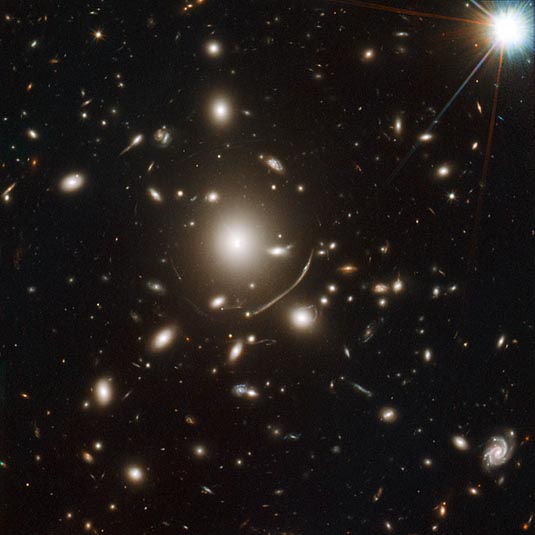
Surprisingly Young Galaxy
Description: Galaxy Cluster
Position (J2000): R.A. 02h 48m 06s.96 Dec. -03° 29' 31".81
Constellation: Eridanus
Distance: 2.48 billion light-years (762 million parsecs)
Instrument: ACS and WFC3/IR
Exposure Date(s): November 2010 through March 2011
Filters: F775W (i), F814W (I), F850LP (z), F110W (YJ), F125W (J), F160W (H)
Image Credit: NASA, ESA, J. Richard (Center for Astronomical Research/Observatory of Lyon, France), and J.-P. Kneib (Astrophysical Laboratory of Marseille, France)
Release Date: April 12, 2011
ABOUT THIS IMAGE:
Astronomers have uncovered one of the youngest galaxies in the distant universe, with stars that formed 13.5 billion years ago, a mere 200 million years after the Big Bang. The finding addresses questions about when the first galaxies arose, and how the early universe evolved.
NASA's Hubble Space Telescope was the first to spot the newfound galaxy. Detailed observations from the W.M. Keck Observatory on Mauna Kea in Hawaii revealed the observed light dates to when the universe was only 950 million years old; the universe formed about 13.7 billion years ago.
Infrared data from both Hubble and NASA's Spitzer Space Telescope revealed the galaxy's stars are quite mature, having formed when the universe was just a toddler at 200 million years old.
The galaxy's image is being magnified by the gravity of a massive cluster of galaxies (Abell 383) parked in front of it, making it appear 11 times brighter. This phenomenon is called gravitational lensing.
Hubble imaged the lensing galaxy Abell 383 with the Wide Field Camera 3 and the Advanced Camera for Surveys in November 2010 through March 2011.
From the ESA Release:
The giant cluster of elliptical galaxies in the center of this image contains so much dark matter mass that its gravity bends light. This means that for very distant galaxies in the background, the cluster's gravitational field acts as a sort of magnifying glass, bending and concentrating the distant object's light towards Hubble. These gravitational lenses are one tool astronomers can use to extend Hubble's vision beyond what it would normally be capable of observing.
Using
Abell 383, a team of astronomers have identified and studied a galaxy
so far away we see it as it was less than a billion years after the Big
Bang. Viewing this galaxy through the gravitational lens meant that the
scientists were able to discern many intriguing features that would otherwise
have remained hidden, including that its stars were unexpectedly old for
a galaxy this close in time to the beginning of the Universe. This has
profound implications for our understanding of how and when the first
galaxies formed, and how the diffuse fog of neutral hydrogen that filled
the early Universe was cleared.